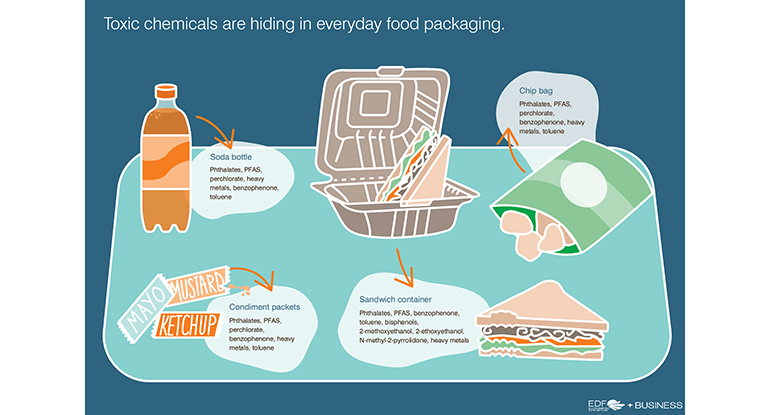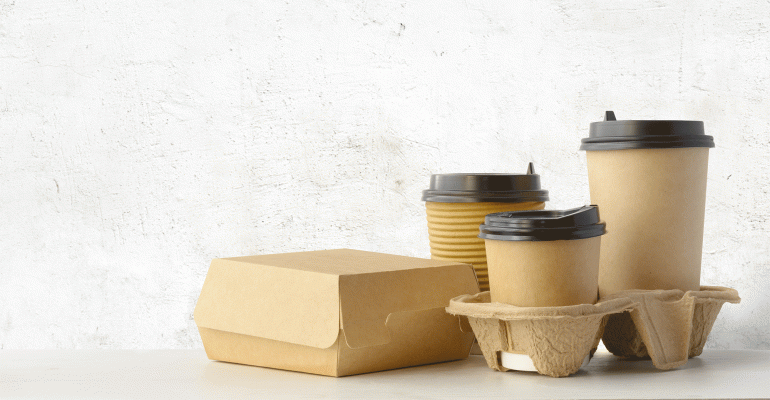With fears of lawsuits looming and regulations coming into play, restaurant operators face growing pressure to find foodservice packaging that is free of toxins that can leach into food.
As off-premises dining grows, so has the world of to-go packaging, with many suppliers and manufacturers making claims about the sustainability of their products. Often the more healthful options are also more expensive.
How can restaurant operators know what’s the best choice for protecting human health and the planet?
The Environmental Defense Fund, a New York-based nonprofit that seeks solutions to environmental problems, has launched a new free web tool that can help.
The website offers information about common food containers — including everything from paperboard to plastic clamshells and metal cans — and “chemicals of concern,” based on the environmental group’s findings.

Among the chemicals are PFAS, or per and polyfluoroalkyl substances often used to make packaging more grease and water resistant. These “forever chemicals” have been linked to cancer, developmental problems for children, birth defects and liver disease, among other health issues.
Earlier this year, Consumer Reports tested more than 100 packaging products from 24 large restaurant chains and grocery stores, finding that nearly half had at least one product with high PFAS levels.
The Centers for Disease Control and Prevention says the human health impact of exposure to PFAS is still uncertain, but research indicates widespread exposure across the U.S. population. And animal and epidemiologic studies document several health effects.
Use of PFAS in food packaging is also increasingly being targeted by state regulations, with bans approaching in California, Maine, Connecticut, Minnesota, New York state, Vermont and Washington state, for example.
But PFAS isn’t the only toxin to worry about, the Environmental Defense Fund contends.
Other chemicals of concern include phthalates, used to make plastics more flexible; benzophenone, which is used in inks on paperboard packaging; perchlorate, used in plastic to keep dry goods from sticking to containers; and more.
Some of these chemicals are used to manufacture the containers, while others are introduced in the production and supply chain process.
Boma Brown-West, director of consumer health for the Environmental Defense Fund, said the goal is to help restaurant operators understand what’s out there.
“The restaurant industry has really prioritized trying to offer more sustainable packaging options as we see the toll that packaging waste is taking on our planet. What this tool is about is to also make sure, as restaurants seek out new ways to provide that packaging and foodware materials, that they’re also recognizing that not only is packaging a problem from a waste standpoint, it’s also a problem from a toxic chemical standpoint,” said Brown-West.
For many restaurants, this will be a journey, Brown-West noted — particularly as the industry faces supply chain challenges that make packaging difficult to find, and more expensive.
“But the first step is knowing what the chemicals of concern are,” she said. Then restaurant companies can better create a plan for moving to safer alternatives.
“We really want to broaden minds about what sustainability means,” said Brown-West. “It’s not only about ‘can I recycle this in the end,’ it’s about ‘is this safe for what it’s used for’ and whether it will harm customers.”
Several large restaurant chains, including Starbucks, McDonald’s, Wendy’s, Chipotle Mexican Grill and Burger King, have pledged to phase out use of added PFAS in packaging by a specific date over the next two years.
The Environmental Defense Fund recommends that restaurant companies create a broader written corporate chemicals policy that outlines restricted substances and a plan of action. A template for such policy is also offered on the website.
The site offers advice for effective testing of packaging within a company’s portfolio, and it offers a link to a scorecard that takes a science-based approach to rate types of packaging based on their environmental impact.
The Understanding Packaging, or UP, Scorecard considers factors like a product’s carbon footprint, its contribution to the plastic pollution problem, water use and recoverability, as well as use of toxins.
A paperboard takeout container lined with polyethylene and made with 25% recycled material, for example, scores pretty highly in terms of not contributing to plastic pollution, carbon production and water use. But it ranks very poorly as having chemicals of concern and not being recoverable. And it is below average on the sustainability of source materials.
The UP Scorecard and Environmental Defense Fund are hosting a free one-hour webinar on the packaging issue is scheduled for Wednesday, June 1, at noon ET.
Contact Lisa Jennings at [email protected]
Follow her on Twitter: @livetodineout





